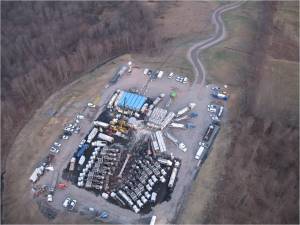[vc_row animation=””][vc_column width=”1/1″][vc_column_text]Post contributed by Bill desRosiers – Coordinator, External Affairs[/vc_column_text][/vc_column][/vc_row][vc_row animation=””][vc_column width=”1/1″][vc_column_text]Far too often, hydraulic fracturing is portrayed negatively in the media because the science behind it is too complicated to explain in a few, short sentences. However, this hasn’t stopped some reporters from trying to clarify the process. Most recently, David Pogue (New York Times, Scientific America) tried his best to un-complicate the process on a CBS Sunday Morning Show piece titled Digging into the Practice of Fracking. To his credit, Pogue does a fair job with the help of some easy-to-understand examples; in particular, the cake he uses to explain the geologic layering of the earth and how the industry drills through it responsibly. But some of the information Pogue presents is out-of-context and not representative of the industry and of Cabot. I would like to take this opportunity to discuss some of these errors:
[/vc_column_text][/vc_column][/vc_row][vc_row animation=””][vc_column width=”1/1″][vc_custom_heading text=”Drilling Vs. Hydraulic Fracturing” font_container=”tag:h2|font_size:32px|text_align:left|line_height:34px” google_fonts=”font_family:PT%20Sans%3Aregular%2Citalic%2C700%2C700italic|font_style:400%20regular%3A400%3Anormal”][/vc_column][/vc_row][vc_row animation=””][vc_column width=”1/2″]
This particular section provides some background on the difference between drilling and hydraulic fracturing – two unique processes that are designed to complement one another:
- Drilling – The initial step in recovering oil or gas from the earth, drilling connects the surface of the earth to a reservoir beneath the ground where natural resources are located. A common misconception is showing a drilling rig – the iconic picture of an erected derrick standing 120 feet in the air – with the words “fracking” next to it. It is unreasonable to connect the two processes as a derrick is a crane which stabilizes piping during the drilling process. The derrick is utilized to lift piping in and out of a well and is also important in placing barriers – layers of steel casing and cement – at specific depths to protect local acquirers, which in-turn protects the environment.
 Hydraulic Fracturing – A stimulation process, independent of drilling, used to free oil and gas from a specific, geologic formation. The utilization of hydraulic fracturing improves the overall production of a well, especially in formations with low permeability. Take the Marcellus Shale for example: 300 million years ago, organic matter settled into tiny, earthen pockets that eventually hardened into impermeable seals. Over time, heat and pressure transformed this organic material into natural gas; these seals prevent the gas from moving, resulting in low permeability. The process of hydraulic fracturing uses pressurized water to open up pathways to otherwise-trapped natural gas.
Hydraulic Fracturing – A stimulation process, independent of drilling, used to free oil and gas from a specific, geologic formation. The utilization of hydraulic fracturing improves the overall production of a well, especially in formations with low permeability. Take the Marcellus Shale for example: 300 million years ago, organic matter settled into tiny, earthen pockets that eventually hardened into impermeable seals. Over time, heat and pressure transformed this organic material into natural gas; these seals prevent the gas from moving, resulting in low permeability. The process of hydraulic fracturing uses pressurized water to open up pathways to otherwise-trapped natural gas.
[/vc_column][vc_column width=”1/2″][vc_single_image css_animation=”” image=”2713″ border_color=”” img_link_large=”” link=”http://cabotsusq.files.wordpress.com/2013/01/drilling-process.jpg” img_link_target=”_self” img_size=”medium”][/vc_column][/vc_row][vc_row animation=””][vc_column width=”1/1″][vc_custom_heading text=”What Chemicals are used in Fracturing ?” font_container=”tag:h2|font_size:32px|text_align:left|line_height:34px” google_fonts=”font_family:PT%20Sans%3Aregular%2Citalic%2C700%2C700italic|font_style:400%20regular%3A400%3Anormal”][/vc_column][/vc_row][vc_row animation=””][vc_column width=”1/1″][vc_column_text]
After asking for the additives used by Cabot in hydraulic fracturing – which are 99% water and sand, biocide (hand sanitizer), corrosion inhibitor, an acid and a surfactant (hand soap) – Pogue suggests there are more “scarier additives than hand soap,” citing the EPA as his source.[/vc_column_text][/vc_column][/vc_row][vc_row animation=””][vc_column width=”1/1″][vc_column_text]The major misconception here is each additive from the EPA’s comprehensive list of additives is used during every hydraulic fracturing operation; this is incorrect and taken out-of-context. What Pogue fails to elaborate are factors like saturation, pressure, depth, formation composition and permeability determine which additives are needed to hydraulically fracture a well. Not every possible additive is needed to hydraulically fracture a well. [/vc_column_text][/vc_column][/vc_row][vc_row animation=””][vc_column width=”1/1″][vc_column_text]Larry Fulmer, Cabot’s superintendent of hydraulic fracturing in Susquehanna County, often clarifies this misconception with an analogy to baking a cake, saying: “Most baked goods will require flour, eggs and water. A pie needs a fruity filling while carrot cake needs cinnamon and, obviously, carrots.” Like baking, hydraulic fracturing requires only certain, limited ingredients.[/vc_column_text][/vc_column][/vc_row][vc_row animation=””][vc_column width=”1/1″][vc_column_text]In a direct response to Pogue’s original question about what additives Cabot is using, the answer can be found at FracFocus.org: a chemical disclosure registry in which Cabot (and many other Marcellus Shale operators) participates in. The website is full of useful information on the natural gas well drawn from Marcellus Shale. Information found on the site includes total depth, water usage and additives, as well as, information about the supplier for each additive.
[/vc_column_text][/vc_column][/vc_row][vc_row animation=””][vc_column width=”1/1″][vc_custom_heading text=”How Many Wells Exist?” font_container=”tag:h2|font_size:32px|text_align:left|line_height:34px” google_fonts=”font_family:PT%20Sans%3Aregular%2Citalic%2C700%2C700italic|font_style:400%20regular%3A400%3Anormal”][/vc_column][/vc_row][vc_row animation=””][vc_column width=”1/1″][vc_column_text]
While I agree 100% with Pogue’s assessment that “fracking has been incredibly successful,” he is way off on the number of producing oil and gas wells in this country. A quick search on EPA.gov reveals a much more significant number: 500,000 producing wells. As for the total number of wells fracturing during the last 60 years, experts debate it’s somewhere in the 1.5-2 million range.[/vc_column_text][/vc_column][/vc_row][vc_row animation=””][vc_column width=”1/1″][vc_column_text]Once again, I would like to thank Pogue for his fair representation of the natural gas industry, especially Cabot. The correction of these errors should not diminish the importance of Pogue’s Digging into the Practice of Fracking or his attempt to de-complicate hydraulic fracturing. Cabot believes discussions about natural gas – whether it’s the process, energy security, or alternative uses – is important as long as the facts are correct.[/vc_column_text][/vc_column][/vc_row]


